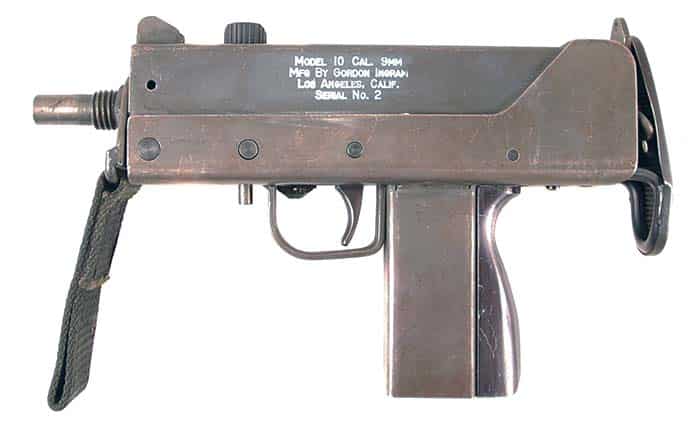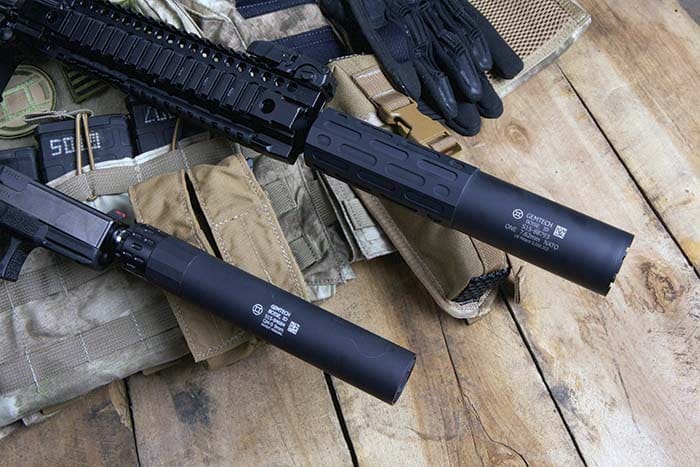The oldest surviving Ingram Model 10, serial number 2. (Courtesy Jeff Hooper)
By Frank Iannamico
In 1964, while working at the Erquiaga Arms Company, Gordon Ingram fabricated a compact submachine gun he chronologically designated as his Model 10. The original Model 10 was 9mm, full-automatic only, and was included in Erquiaga’s October 1964 catalog. There were no orders for the weapons, and Ingram’s original prototype Model 10 was confiscated in a government raid. An improved Model 10, serial number 2, was built during July 1965.
Mr. Ingram had a brochure printed up describing his Model 10, listing its attributes and specifications. The brochure was mailed to domestic and foreign firearms manufacturers and governments. During this period, the United States and many foreign armies, had recently adopted the select-fire mid-range assault rifle that fulfilled the role of the submachine gun and battle rifle in one weapon. It seemed the era of the pistol caliber submachine gun as a military weapon, was over. No one was interested in Ingram’s submachine gun.
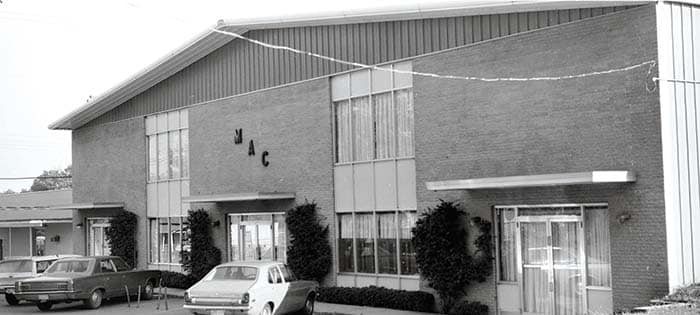
The Military Armament Corporation is Born
Mitch WerBell III of Powder Springs, Georgia served with the Office of Special Services (OSS), forerunner of the CIA, during World War II. During the 1950’s, WerBell decided to get into the clandestine weapons business. His specialty was sound suppressors. Mr. WerBell named his company Sionics; it was an organization that specialized in counterinsurgency equipment.
During 1969, Gordon Ingram met with Mitch WerBell to demonstrate his prototype Model 10 caliber .45 submachine gun. Duly impressed with Ingram’s M10 as the perfect covert weapon, WerBell struck a tentative deal with Ingram, whereby he would take several of his submachine guns to Vietnam, and demonstrate them along with his Sionics suppressors. No Sionics made suppressors had yet been designed for the Ingram Model 10. The .45 caliber suppressor taken to Vietnam had been designed and built by Gordon Ingram.
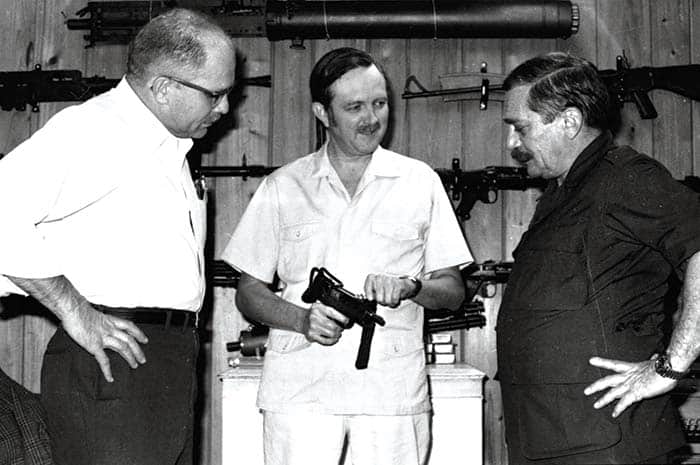
Despite all of the previous rejections of his Model 10 submachine gun by the firearms industry, the suppressed weapon was an immediate hit in Vietnam. WerBell immediately contacted the Sionics Company officials back in Georgia, instructing them to contact Gordon Ingram and begin negotiations for the rights to manufacture his Model 10 submachine gun. WerBell offered Ingram a job as the Chief Engineer to oversee production.
Soon after Ingram joined Sionics, Mitchell L. WerBell III decided that the company name needed updating, and on 21 December 1970, the new name, Military Armament Corporation name became official. A new company trademark for application on all MAC products was introduced. Featured on the insignia was a mythical creature that was part Cobra snake and part Moray eel: a Cobray, wrapped around the world, which was covered with crosshairs from a rifle telescope.
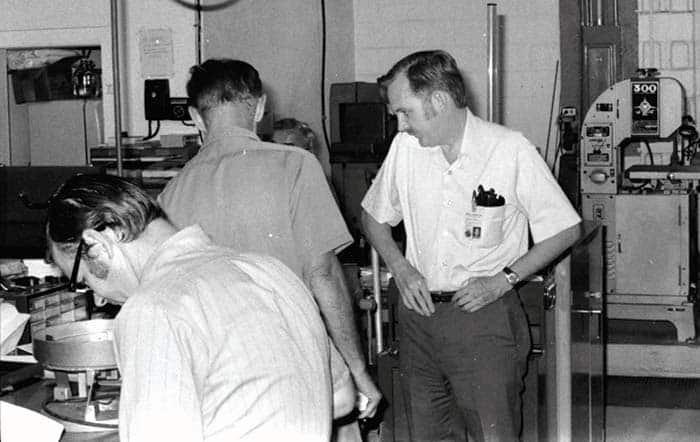
The Quantum Corporation
On 11 June 1969, the Military Armament Corporation became a wholly owned subsidiary of the Quantum Ordnance Bankers Inc. of New York (who later changed their name to the less conspicuous Quantum Corporation). Quantum, headed by Rosser Scott Reeves III, was a holding company that was formed by a group of wealthy Wall Street financiers, to pump millions of dollars into the Military Armament Corporation. Investors were interested in MAC because they had been convinced that the U.S. Army was going to replace the 1911A1 pistol with Ingram’s submachine gun.
MAC Marietta, Georgia
As production of the Ingram submachine guns increased, the company quickly outgrew the Powder Springs production facility that was located on WerBell’s property. During February of 1970, the company relocated into a much larger facility on Glover Street in Marietta, Georgia. After relocating, the company address on the Ingram submachine guns made at the new facility was changed from Powder Springs, GA to Marietta, GA.
Shortly after the Quantum takeover of MAC, a bitter struggle broke out within the company over policies, procedures and operations. This struggle soon erupted into an all-out war within the organization. On 17 May 1972, Mr. WerBell and Ingram were forced completely out of the company. Quantum management then permanently changed the name of the Ingram submachine gun, to which they held all rights, to the MAC submachine gun (Military Armament Corporation). The M10 and M11 receivers with Ingram’s name on them were immediately pulled from the production line and placed in storage. Receiver production continued without the Ingram name, which was replaced by the name “MAC” on all M10 and M11 submachine guns. All weapon manuals, literature and advertising had the Ingram name replaced by MAC.

MAC Bankruptcy
By late 1974, the Military Armament Corporation was experiencing irreversible financial problems, resulting from mounting law suits, an over-staffed management team and a lack of sales. During 1975, the Military Armament Corporation began to default on payments to creditors, in December the Military Armament Corporation was forced to file for bankruptcy. There were several other contributing factors that lead to the demise of the Military Armament Corporation. One was the failure of the U.S. Army to adopt the small Model 11 submachine gun. Another was the U.S. State Department’s decision to stop all suppressor sales to foreign governments.
The MAC Auction
By April of 1976, the remaining inventory and assets of the Military Armament Corporation were ordered by a District Bankruptcy judge to be sold. The auction commenced at 10:00 am EST on 14 June 1976, and lasted for two days. The auction was held at the MAC factory on 440 Glover Street, Marietta, Georgia. Only those possessing valid FFL/SOT licenses were permitted to attend and bid at the auction, less than forty individuals were present.
Potential bidders were offered an extensive inventory of suppressors, and pallets of MAC submachine guns. Material presented at the auction consisted of: 2400 9mm Model 10 submachine guns, 6400 .45 caliber Model 10 submachine guns, 174 .380 caliber Model 11 submachine guns, 600 Stingers and 1925 suppressors of various calibers. There also large lots of receiver flats, parts and related components. There were many suppressor internal parts and tubes, but the ATF would not permit them to be sold. The manufacturing equipment, tooling, and test stands were sold at auction a week or so later. Reportedly, many of the submachine guns were sold as low as $600.00 for a pallet of one hundred guns, and there were few takers!
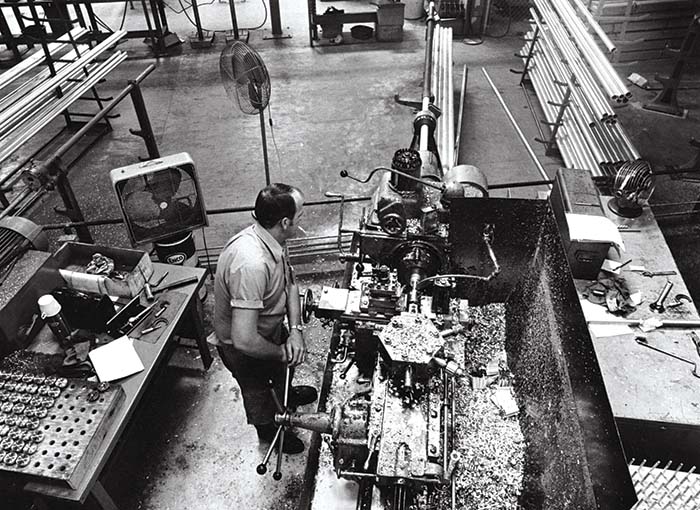
RPB Industries
After the demise of the Military Armament Corporation, three former employees; Ray R. Roby, Charles T. Pitts and Richard W. Brueggeman decided to form a new company to manufacture and continue selling Ingram/MAC submachine guns. With their collective knowledge of the business, the three men obtained the exclusive rights to manufacture the Ingram M10 and M11 submachine guns under the name RPB Industries Inc. The company was officially incorporated on 9 August 1976. The letters RPB represented the initials of the new owner’s last names. The company operated out of a building located at 1088 Huff Road N.W. Atlanta, Georgia. RPB had procured a number of lower receivers and parts prior to the MAC bankruptcy auction, but had only a limited supply of upper receivers, cash was tight and the company didn’t have sufficient funds to order a new run of the needed parts. By January of 1977, the under financed RPB Industries, Inc. was beginning to experience serious cash flow problems.
The Second RPB Industries
The original RPB Company, was short-lived. The company only remained active in business until the fall of 1977. During 1978, Wayne Daniel along with several investors, acquired RPB for $105,000; $90,000 went to the RPB partners for their inventory and $15,000 to J.P. Maguire Inc. for the company. The new partners soon resumed manufacture of the submachine guns under the RPB Industries Inc. name at a new location: 215 Chester Ave SE, Atlanta, Georgia, the same address as Mr. Daniel’s other firearms’ company Precision Armament.
The RPB Liquidation
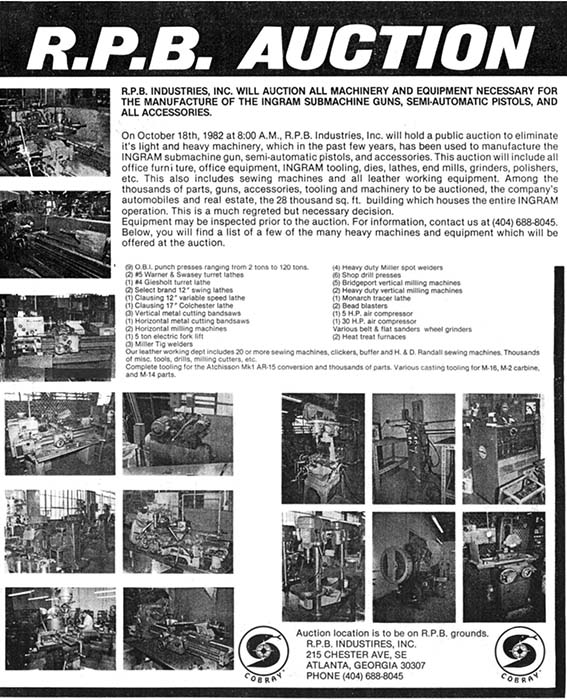
Wayne E. Daniel’s RPB partners were allegedly involved in a few questionable ventures. As a result, a lot of unwanted attention was being focused on RPB from the authorities. Another problem facing RPB, was the semiautomatic open-bolt SAP (Semi Automatic Pistol) SM10 pistols that had been previously manufactured, were coming under increasingly heavy scrutiny from the BATF. In a desperate attempt to distance himself from all the attention, Wayne Daniel decided to discontinue doing business as RPB, and liquidate the corporation’s assets. RPB Industries Incorporated was officially dissolved on 21 April 1982. On 18 October 1982, RPB auctioned off their shop equipment and tooling. The Advanced Armament Corporation (James Leatherwood) bought the M10/9mm tooling, while the M10/45 caliber tooling was sold to Jones and Cox, an oil drilling company from Oklahoma. Eventually Mr. Leatherwood was able to obtain the .45 M10 tooling.
SWD Inc.
Several weeks before RPB was officially out of business one of the former partners, Wayne Daniel, started a new company naming it SWD, officially incorporating on 2 April 1982. Mr. Daniel had the manufacturing rights to the Ingram Model 11 submachine gun and the Cobray trademark. The company was initially located at 1872 Marietta Boulevard, Atlanta, Georgia. Under the SWD banner, Wayne Daniel introduced a new, small frame 9mm variation of the basic Ingram design, designating it as the M11/Nine in the summer of 1983. The new M11/Nine was available in a select-fire submachine gun form, or as a new BATF approved, closed-bolt operated, semiautomatic-only, pistol. SWD also marketed the M11-A1, a small frame .380 caliber submachine gun, also available in a semiautomatic-only pistol configuration. SWD marked all of their products with the Cobray logo, which differed slightly from its original form used by the Military Armament Corporation. As stamped on their products the SWD Cobray trademark was enclosed inside of a circle, and had the word Cobray at the bottom, and occasionally included a circled letter ® suffix indicating it was registered. The Cobray trademark stamped on the original MAC and RPB receivers was not encircled, and did not include the name Cobray.
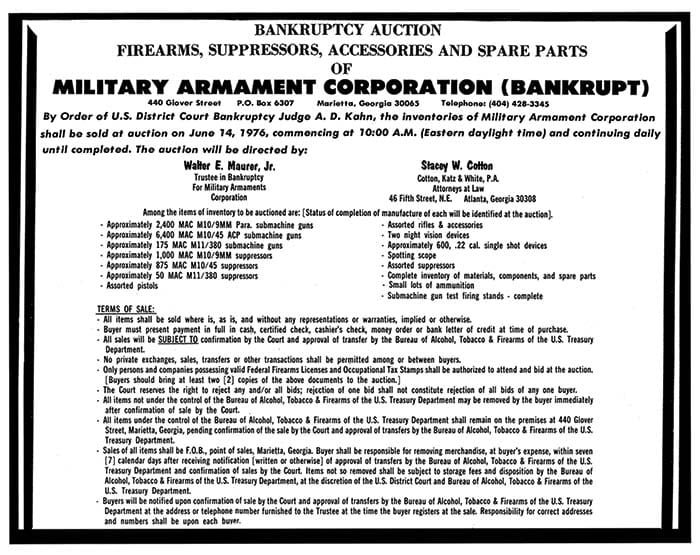
The Daniel’s operation was run far more efficiently than the original Georgia based Military Armament Corporation. The SWD Company had far less overhead; there was no large management staff, no over-paid executives, no overseas sales agents, no large prototype shop or engineering department. Wayne Daniel often worked on the production line right alongside his employees. During its peak, SWD had 55 employees. The SWD Company did more with less, and was more successful than the Wall Street financed Military Armament Corporation.
The End of SWD
The Federal Firearms License of SWD was officially surrendered to ATF on 23 March 1994. Firearm sales continued at companies owned or associated with SWD, most of the entities were established during 1993, about the same time SWD went out of business. Many of the companies were located just across the Georgia border in Tennessee. The firms included; Mountain Accessories Corporation (MAC), Full Metal Jacket (FMJ), Cobray Firearms, Street Sweeper Sales Inc., All Purpose Ammo, The Ultra Force, Et Cetera, S&L Sales, D&L Sales, Excalibur and Leinad (Daniel spelled backwards). The companies sold knives, semiautomatic-pistols, suppressors, flare launchers, derringer pistols, part sets, accessories, receiver flats, fake suppressors, cane guns, shotguns and many other similar items.
The Texas MACs
During the 1970s, James Leatherwood had worked as an engineer with the Military Armament Corporation. Mr. Leatherwood left MAC in May 1972, and returned to Stephenville, Texas. Together, with his brother Charles, also a former MAC employee, formed a business partnership they called Leatherwood Brothers. The enterprise was organized to manufacture the auto-ranging rifle telescope that James had invented. From 1972 until 1975 their primary business was making telescopic sights for military use.
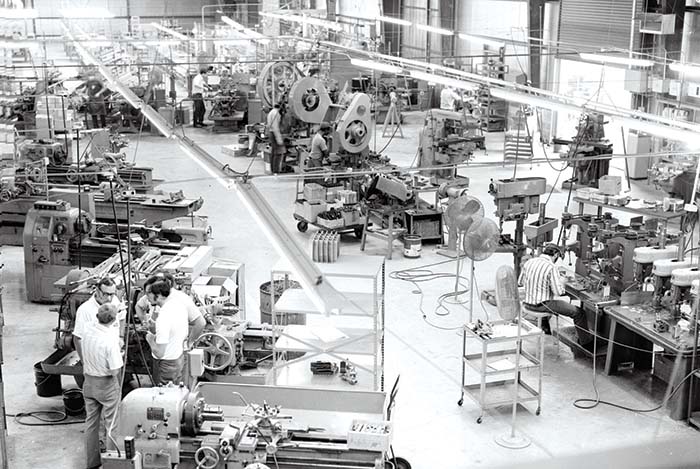
During 1980, the parts and tooling of RPB Industries was being liquidated. The Leatherwood brothers acquired the rights, to the Model 10 submachine gun design. Mr. Leatherwood also bought the remaining stock of Model 10 receiver flats and parts from Wayne Daniel in October of 1982. Although they did make a number of submachine guns, the Leatherwood brothers’ primary goal was to design and manufacture a semiautomatic pistol version of the Ingram Model 10. Gordon was asked him to endorse the new MACs as the “official” Model 10, by allowing his name to be placed on his new Texas made M10 pistols and submachine guns for a royalty fee, Ingram agreed.
The Texas M10A1 Submachine Gun
After implementing a few design changes in the Ingram Model 10, Leatherwood began production under the Military Armament Corporation name. Leatherwood’s new Ingram M10A1, which became better known, as the “Texas MAC”, with a few improvements incorporated into the basic design. The Texas Model 10A1 pistols and submachine guns were available in 9mm or .45 caliber. However, the Texas MACs encountered a number of problems because of the decision to use spot-welds in their construction.
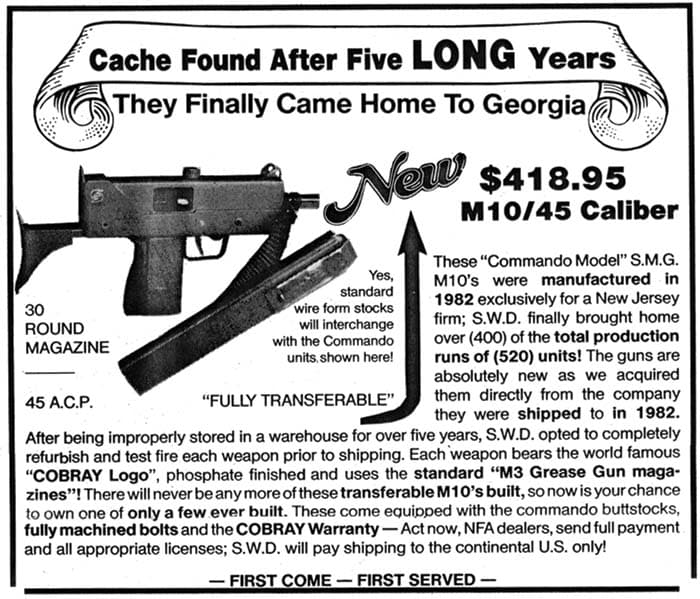
The Texas MAC M10A1S Semiautomatic Pistols
The first M10A1S semiautomatic pistols were produced by Texas MAC in 1984. The pistols were essentially the same design throughout their production, primarily differing from earlier RPB semiautomatic models by their closed-bolt operation. Other differences included the design of their bolts, large cocking handle, open rear sight notch, trigger guard safety levers, front receiver pin, spot-welded receivers and the method that was used to attach their barrels.
The Commemorative Ingram M10
The American Historical Foundation decided to offer a “U.S. Army Special Forces” .45 caliber Ingram M10 to commemorate the use of the weapon by some U.S. Army units during the Vietnam War. The Model 10 closed-bolt pistols for the original project were purchased from Leatherwood’s Texas MAC Company. All of the Commemorative MACs were semiautomatic; wire buttstocks were added to give the appearance of a submachine gun, but to be legal, were permanently fixed in a folded position.
Gordon Ingram had signed a royalty agreement with James Leatherwood allowing him to use the Ingram name on his M10 pistols and submachine guns, but not those sold to the American Historical Foundation. The short-lived AHF Commemorative program yielded only a limited number of Ingram marked M10 pistols, making them highly desirable today by MAC collectors. The Commemorative M10 program continued with subsequent Leatherwood’s Texas guns being marked “MAC 10” in place of “Ingram”. Later production Commemorative “MACs” were supplied by Masterpiece Arms.
The End of Texas MAC
The Texas Military Armament Corporation ceased doing business during 1993 and all of the guns and parts sold off. Wayne Daniel eventually was able to purchase all of the registered M10 frames and components, the very same ones that he had originally sold to James Leatherwood. Mr. Daniel re-assembled them with a combination of RPB and SWD manufactured parts. The Texas/SWD 9mm guns used the same SWD Zytel magazines as the M11/Nine.
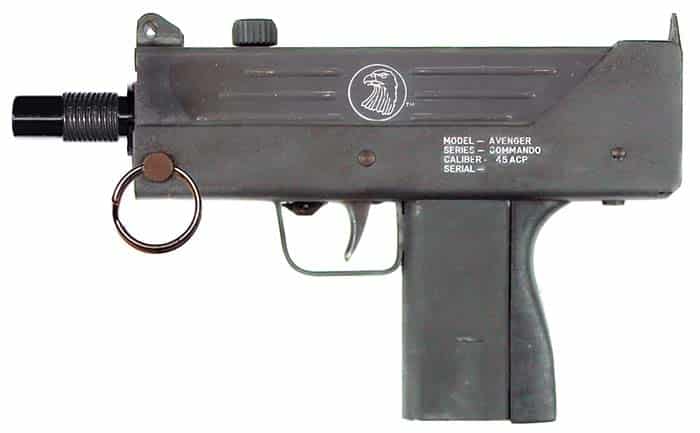
The Jersey Arms Works
During the mid-1980s, RPB introduced an open-bolt, semiautomatic-only version of their Model 10 “MAC” submachine gun. RPB’s SM10 design was originally classified by the BATF as a pistol and available to anyone that could legally buy a handgun. The SM10 was an instant hit with the gun buying public. Noting the success that RPB was having, Dominic Spadea, owner of Hatton Industries, a licensed firearms manufacturer in Westmont, New Jersey, decided to produce his own version of the semiautomatic-only “MAC” pistol. Mr. Spadea founded a new company he called the Jersey Arms Works or “JAWS” specifically formed to market his new pistol he designated the S-7 Avenger. The Avenger used the same open-bolt design as RPB’s SM10 semiautomatic pistol.
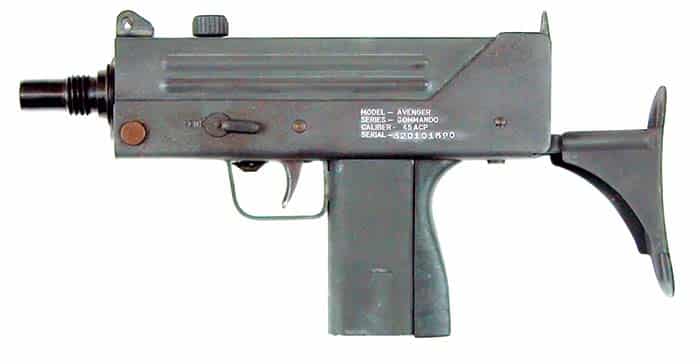
The BATF Technical Branch inspected a sample of the S-7 pistol. After their examination, the technicians advised the Jersey Arms Company representatives that the S-7 Avenger would most likely be classified as a machine gun, because of the weapon’s open-bolt operation and fire control components. At this time, Hatton Industries had receivers and enough parts to assemble 500 complete firearms. The BATF letter stated that the S-7 Avenger pistol was the same (open-bolt) design and function as the SAP SM10 firearm manufactured by RPB Industries, Georgia, which was reclassified as a machine gun by a BATF letter dated 20 May 1982. Since the S-7 Pistol was the same design and function as the SAP SM10, the S-7 Avenger was also being classified as a machine gun, regardless of their date of manufacture. There were 520 of the New Jersey S-7 Avenger submachine receivers manufactured before they were redesigned, and subsequently approved, by the BATF as semiautomatic pistols. During February 1983, Jersey Arms Works ran an ad in the Shotgun News. The ad offered the “1st Edition” of the S-7 Avenger. The ad stated that the S-7 was available as a semiautomatic-only pistol or full-automatic submachine gun, but in either configuration had to be sold as an NFA weapon, requiring a prospective buyer to go through the BATF paperwork procedure. The weapons offered in the ad were built on the receivers that the BATF had determined were machine gun receivers. The Jersey Arms Works sold 143 completed guns before the company folded in 1984, and the remainder of the unassembled receivers placed in storage.
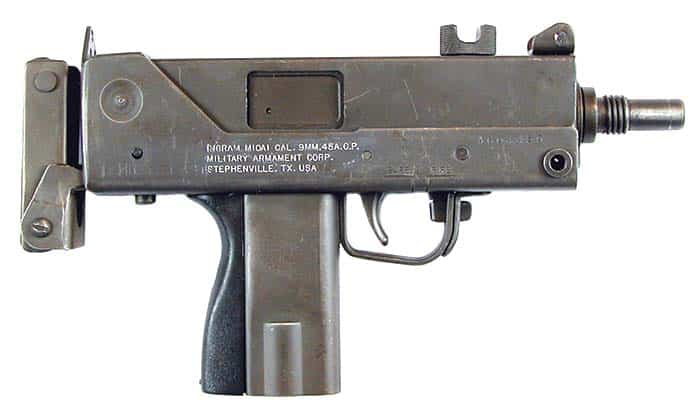
Wayne Daniel of SWD purchased the entire inventory of Jersey Arms’ 377 unsold receivers in 1987. According to Wayne Daniel, the Jersey Arms submachine gun receivers were brand new, but had been improperly stored and needed attention. SWD replaced the receiver’s back plate with one having the MAC/RPB type rear sight, drilled a hole in the receiver for the sear pin, and modified the receiver to accept a buttstock. The buttstocks that were the same configuration as those used on the MAC carbines and SWD’s Terminator shotguns. The rest of the parts used to assemble the receivers were RPB M10 parts. The guns were refinished, test-fired and stamped with the Cobray trademark. The fully transferable submachine guns were advertised in a 1988 issue of the Shotgun News for $418.95 each shipped.
Learn more MAC history available in the book Gordon Ingram, the MAC MAN, available from Chipotle Publishing LLC.
| This article first appeared in Small Arms Review V20N1 (January 2016) |



